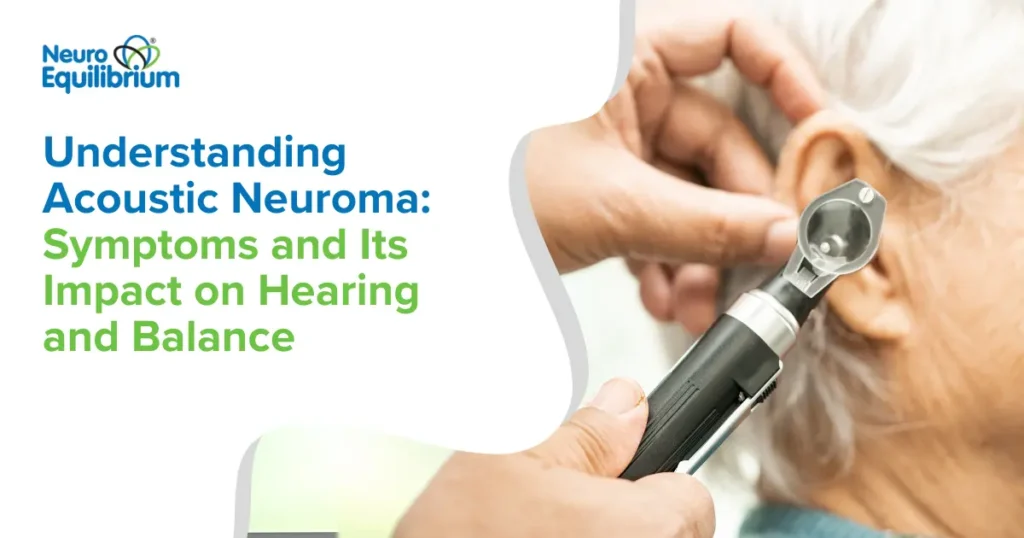Acoustic neuroma is a type of non-cancerous growth (tumor) that forms on a nerve called the vestibulocochlear nerve. This nerve connects your ear to your brain and helps you hear sounds and keep your balance. Even though these tumors aren’t life-threatening, they can still cause problems as they grow.
When the tumor gets bigger, it can press on your ear, leading to hearing issues or a constant ringing sound, called tinnitus. Some people may also feel dizzy or have trouble balancing.
Symptoms of Acoustic Neuroma
The symptoms can vary, but here are the most common ones:
- Hearing Loss in One Ear: One ear might stop hearing as well as the other. This is often the first sign of the condition.
- Tinnitus: A buzzing or ringing sound in your ear that doesn’t go away.
- Dizziness or Balance Problems: You might feel like the room is spinning (vertigo) or have trouble staying steady.
In rare cases, symptoms can be hard to identify, which makes it tricky for doctors to diagnose early. Knowing these signs can help you or someone you know get checked and treated sooner.
What Causes Acoustic Neuroma?
Acoustic neuromas, also called vestibular schwannomas, happen because of unusual growth in Schwann cells. These cells surround and protect the vestibulocochlear nerve. While doctors don’t know the exact cause, here are some risk factors:
- Genetic Factors:
- Neurofibromatosis Type II (NF2): A rare genetic condition that can lead to tumors on both sides of the head.
- Family History: If relatives have had acoustic neuroma, you might be at a higher risk.
- Environmental Factors:
- Loud Noise Exposure: Being around loud sounds for years, like at work or during loud hobbies, might increase your risk.
- Age and Gender: This condition is more common in adults aged 30 to 60 and is slightly more likely to affect women.
Understanding these symptoms and risk factors can help spot the condition early. If you or someone you know is experiencing these symptoms, it’s important to talk to a doctor for proper care and support.
Diagnosis of Acoustic Neuroma
When doctors think someone might have an acoustic neuroma, many tests are done to figure it out. The symptoms can resemble other ear problems, like Meniere’s disease or ear infections.
Important Steps in Diagnosing Acoustic Neuroma:
- Hearing Test (Audiogram): Doctors test how well you can hear different sounds. Hearing loss, especially in just one ear, could be a sign of acoustic neuroma.
- MRI Scan: This test uses powerful magnets to take detailed pictures of the brain. It helps doctors determine the tumor’s size and location.
- Balance Tests: These check if your inner ear, which controls balance, works as it should.
Other symptoms like ear ringing (tinnitus), dizziness, or facial weakness might also indicate acoustic neuroma. Since these symptoms can also happen with other ear problems, doctors use special equipment to ensure they’re getting it right.

Treatment Options for Acoustic Neuroma
The management of acoustic neuroma depends on the size of the tumor, its rate of growth, and the extent of its impact. Doctors choose one of three main options: surgery, microscope-guided surgery, or radiation treatment. The choice is based on the tumor size and whether the patient’s hearing can be saved.
Observation (Watchful Waiting)
This is often recommended for small tumors (1 cm or less) that are not causing severe symptoms. Patients have regular MRI scans to check if the tumor is growing. However, about 1 in 4 patients may eventually need treatment if the tumor grows. Some people with small tumors may experience hearing loss over time, even if the tumor stays the same size.
Microsurgery
Microsurgery involves removing the tumor through one of three surgical methods:
- Translabyrinthine approach: Through the inner ear, often used for larger tumors but may cause hearing loss.
- Retrosigmoid approach: Through the back of the skull, allowing better hearing preservation in some cases.
- Middle cranial fossa approach: Through the temple, used for smaller tumors to save hearing.
The goal of surgery is to remove the tumor entirely while protecting vital nerves, especially those involved in hearing and facial movement.
Radiotherapy
Radiotherapy is a treatment that uses special rays, like super-focused X-rays, to stop tumors from growing. These rays target the tumor carefully so they don’t harm the healthy parts of your body.
- Stereotactic Radiosurgery (SRS): This is like a one-time blast of powerful radiation aimed at small tumors. It’s quick and works well to keep the tumor from getting more significant.
- Fractionated Stereotactic Radiotherapy (FSRT): For larger tumors (bigger than 3 cm), radiation is given in smaller amounts over several sessions. This helps protect nearby healthy tissue while still treating the tumor.
Radiotherapy can sound scary, but it’s a familiar and safe way doctors use to help people fight tumors.
Rehabilitation
For patients experiencing balance issues or hearing loss, vestibular rehabilitation is often recommended. At NeuroEquilibrium, we provide programs to help patients recover after surgery or manage symptoms without surgery. These therapies focus on restoring balance and improving quality of life, ensuring patients feel supported at every step.
By choosing the proper treatment and support, patients can effectively manage acoustic neuromas and maintain their quality of life.
When to See a Specialist
In case of persistent dizziness, balance problems, or tinnitus i.e. ringing in one of your ears, you should consult a specialist. Other signs that you need medical attention are sudden hearing loss, excruciating headache, or numbness on your face. ENT doctors, neurologists, and physiotherapists who deal with the vestibular system are some of the specialists who can assist. These professionals work hand in hand to diagnose your condition and recommend a treatment plan for your symptoms.
Conclusion
Acoustic neuroma is uncommon but can lead to significant hearing and balance problems. If diagnosed early and with appropriate treatment, most people with acoustic neuroma can have a good quality of life despite the illness. The condition requires early treatment and the intervention of numerous specialists in the management process for the best result.
At NeuroEquilibrium, our outcomes are supported by scientific evidence, ensuring that patients receive better results through individualized approaches for the chronic management of balance disorders, ultimately improving their quality of life.
Frequently Asked Questions (FAQs)
What Is an Acoustic Neuroma?
An acoustic neuroma is a lump that grows on the nerve and is responsible for hearing and balance. This nerve helps you hear sounds and stay steady when you move, like when you’re dancing or playing sports. The lump starts from special cells that protect the nerve and grow very slowly.
Even though it’s not dangerous, the lump can press on the nerve or nearby areas, causing problems like hearing loss, ringing in the ear, feeling dizzy, or trouble balancing. These issues don’t threaten your life, but it’s essential to catch the problem early so it doesn’t get worse.
Book a consultation at your nearest NeuroEquilibrium Clinic today.
What Are the Common Symptoms of Acoustic Neuroma?
The first sign is often a ringing sound in one ear, which might feel like buzzing or hissing. You might also notice:
- Hearing getting worse in one ear
- Feeling dizzy or unsteady
- Problems keeping your balance
- Nausea or feeling sick
- Rarely, weakness or trouble moving parts of your face
If you notice these symptoms, see a doctor. Catching it early makes it easier to treat.
Book a consultation at your nearest NeuroEquilibrium Clinic today.
How Is Acoustic Neuroma Diagnosed?
Doctors use special tests to find out if you have an acoustic neuroma:
- Hearing Test: This checks how well you can hear sounds in each ear. Trouble hearing in one ear is often a clue.
- MRI Scan: This test takes detailed pictures of your brain to find out if there’s a lump, how big it is, and where it’s located.
- Balance Test: These tests check if the lump is affecting your inner ear and balance.
These tests also help doctors rule out other problems, like ear infections, so they can find the proper treatment for you.
Book a consultation at your nearest NeuroEquilibrium Clinic today.
What Are the Treatment Options for Acoustic Neuroma?
The way doctors treat an acoustic neuroma depends on how big it is and how much trouble it’s causing.
- For Small Tumors: If the lump isn’t causing problems, doctors might just watch it closely with regular scans.
- For Bigger Tumors: Surgery can remove the lump and try to save your hearing and nerve function.
- Radiation Therapy: This uses special rays to stop the lump from growing and works well for some tumors.
- Rehabilitation: After treatment, exercises and therapy can help improve your balance and hearing.
Doctors at Neuroequilibrium create personalized plans that fit their problems and symptoms to give them the best results.
Book a consultation at your nearest NeuroEquilibrium Clinic today.
Can Acoustic Neuroma Be Cured?
Acoustic neuroma isn’t like a regular sickness that goes away completely, but doctors can manage it. Surgery or radiation can stop the lump from growing or make it smaller, which helps prevent more problems. If the lump grows very slowly or doesn’t cause issues, doctors might just keep an eye on it. After treatment, some symptoms, like hearing loss or ringing, might still be there, but therapy can make life much better. With early diagnosis and the right care, most people can return to their usual activities and feel better.
Book a consultation at your nearest NeuroEquilibrium Clinic today.
















